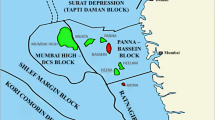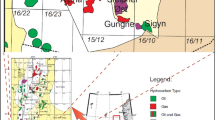Abstract
Hasdrubal is a naturally fractured carbonate reservoir field located in offshore Tunisia. Over the last decade, the field has manifested serious integrity and water coning production issues. The extended network of discontinuities in addition to the impact of reservoir depletion renders the stability of the reservoir a major concern for the field operator. An integrity study of the field was necessary to accurately determine the ever-changing stress settings (magnitudes and orientation of stresses tensors) in order to accordingly adjust the design of well trajectory while properly assimilate their impact on the production trend. An elaborated workflow was initiated to fine-tune mechanical properties of rock basing on geological information, drilling event, and field logs. The one-dimensional mechanical earth model (MEM) was then built to validate wellbore failure and explain drilling incidences reported. The stress regime was also confirmed and matches the geological history of the area with an alteration between normal faulting and strike-slip regimes. The mechanical earth model was in position to explain the drilling events for all the vertical wells and so providing reasonable guide design for the wells under development. The shear stability of faults encountered by horizontal well Hasdrubal-A1 was also appraised using the Fracture Stability Advisor software. The results show that at initial reservoir pressures, the fractures in Hasdrubal field are stable and do not exceed the failure criterion. Previous interpretation is applicable to any major discrete discontinuity that is present in the same stress field and depicts similar rock-related properties strength. A predictive and robust three-dimensional model to represent the complex environment of reservoir is necessary to explain production profile induced from pressure depletion, especially alteration at fractures and faults network, and so improving well planning and long-term field development. The mechanical earth model described herewith has represented an indispensable foundation of the three-dimensional model that has been built to address the classical 1D-MEM limitations and so to properly assimilate the presence of fractures and their impacts on the geomechanical behaviour of the field.























Similar content being viewed by others
References
Al-Ajmi, A. M. and Zimmerman, R. W., 2006 Wellbore stability analysis based on a new true-triaxial failure criterion. Dissertation, University of KTH, Oklahoma, pp.1-5.
Barton NC et al (1997) Strength, deformation and conductivity coupling of rock Joints. Int J Rock Mech Min Sci Geomech Abstr 22(3):121–140 June 1985
Biot MA, Willis DG (1956) The elastic coefficients of the theory of consolidation. J Appl Mech 78:91–96
Clark, S.P., 9ed, 1966, Handbook of Physical Constants: Geological Society of America, Memior 97, 587p.
Coates, G.R. and S.A. Denoo. 1981. Mechanical properties program using borehole analysis and Mohr’s circle. In Trans. SPWLA 22nd Annual Logging Symposium., Mexico City, 23–26 June 1981.
Core Lab (2008); Triaxial compressive test results (XLS spreadsheet); Core Lab project HOU-081219, December 2008.
Dennis, J.W. & Harrison, J.P. (2005); Laboratory test data and analyses - single and multi- stage triaxial compression tests (Miskar and Hasdrubal); Imperial College Report EA85c, to BG Group, August 2005.
Gardner GHF, Gardner LW, Gregory AR (1974) Formation velocity and density - the diagnostic basics for stratigraphic traps. Geophysics 39:770–780
Hobbs DW (1964) Rock compressive strength. Colliery Eng 41:287–292
Carl Robert Johnson et al. (2006). Application of engineered cementing solution to solve long-term cement integrity issues in Tunisia by Klaus Krusche. 100390-MS SPE Conference Paper - 2006.
Kadyrov, T., 2012, Integrated wellbore stability analysis for well trajectory optimization and field development: the West Kazakhstan field, a thesis submitted to Colorado School of Mines, Colorado.
Kallel, N. et al., 2008. Geomechanics modelling and analysis A1 well – Hasdrubal field, British Gas Tunisia Ltd.
Koutsabeloulis et al. (2007). Coupled geomechanics–flow modelling at and below a critical stress state used to investigate common statistical properties of field production data. Structurally Complex Reservoirs Geological Society, London, Special Publications, 292, 453– 468, January 2007
Mañalac, E., & Fuller, J. (2004): Pre-drill wellbore stability evaluation: Hasdrubal field mechanical earth model; Schlumberger report 4GOM00107/GF3.8.1 to BG Group (Hasdrubal team, Tunisia), January 2004.
Morals RH, Marcinew RP (1993) Fracturing of high-permeability formations: mechanical properties correlations. In: Annual technical conference and exhibition, USA, SPE 26561
Ostadhassan, M., Zeng, Z., & Zamiran, S. (2012). Geomechanical modelling of an anisotropic formation- Bakken Case Study. In 46th US Rock Mechanics/Geomechanics Symposium. Chicago: American Rock Mechanics Association.
Petrel Geomechanics Fundamentals Manual version of 2017, Schlumberger Information Solutions, 2017
Plumb, R. A., S. Edwards, G. Pidcock, D. Lee and B. Stace, 2000. The mechanical earth model and its application to high risk well construction projects. In Proceedings of IADC/SPE Drilling Conference, New Orleans, 23-25 February, IADC/SPE 59128.
Plumb, Richard; Edwards, Stephen; Pidcock, Gary; Lee, Donald; Stacey, Brian (2013): The mechanical earth model concept and its application to high-risk well construction projects. In: IADC/SPE Drilling Conference. New Orleans, Louisiana, 2000-02-23: Society of Petroleum Engineers
Sayers, C., S. Kisra, K. Tagbor, A. D. Taleghani and J. Adachi, 2007. Calibrating the mechanical properties and in-situ stresses using acoustic radial profiles. In proceedings of the SPE ATCE, Anaheim, 11-14 November, SPE 110089.
Sayers, C., C. Russel and M. Pelorosso, J. Adachi, J. Pastor, V. Singh, K. Tagbor and P. Hooyman, 2009.Determination of rock strength using advanced sonic log interpretation techniques. In Proceedings of the SPE ATCE, New Orleans, 4 – 7 October, SPE 124161
Techlog Manual, Schlumberger version 2015. Schlumberger Information Solutions, 2015
Warren, J. E. and Root, P. J., 1963, The behaviour of naturally fractured reservoirs, Soc. Pet. Eng. J., Sept., 245–255.
Tymm Wynn, et al. (2010). Hasdrubal field fracture modelling study. TRACS International Consultancy Ltd report to British Gas Tunisia Ltd, July 2006.
Zoback, M. D., Moos, D., Larry Mastin, L. and Anderson, R. N., 1985, Well Bore Breakouts and in Situ Stress. U.S. Geological Survey, Menlo Park, California. journal of geophysical research, vol. 90, No. b7, pages 5523-5530, June 10, 1985.
Author information
Authors and Affiliations
Corresponding author
Additional information
Responsible Editor: Murat Karakus
This paper was selected from the 2nd Conference of the Arabian Journal of Geosciences (CAJG), Tunisia 2019
Rights and permissions
About this article
Cite this article
Ben Abdallah, K., Souissi, S., Essaib, H. et al. Hasdrubal Field, Tunisia: geomechanical integrity study. Arab J Geosci 14, 444 (2021). https://doi.org/10.1007/s12517-021-06564-y
Received:
Accepted:
Published:
DOI: https://doi.org/10.1007/s12517-021-06564-y




